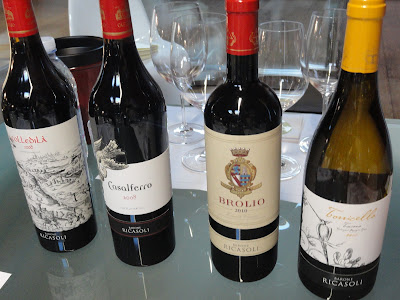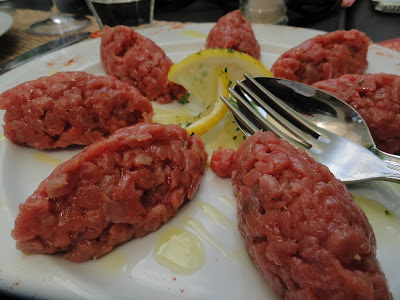4) The quality of Chianti Classico has increased.
Chianti Classico has never tasted better than now, and that high quality will continue to improve in the years to come. In the last 15-20 years, the overall quality of Chianti Classico wine has significantly increased. One of the primary reasons for these changes was related to us on our first winery visit by Alessandro Gallo, the Direttore of Castello D'Albola. Alessandro stated that much of the change was due to a different mindset, which led to numerous changes in the vineyards. He claimed, and which would later be supported by several other producers, that many wine makers once believed that wine was made in the cellars, but now 80-90% of them have come to believe that wine is made in the vineyards.
That change of mindset has been quite significant. The law in Chianti Classico prohibits new vineyards from being planted or from new land being used for vineyards. As we were told, you can't cut down most trees, as the land is very precious, and also well protected. That has led many producers, at least 60%, to replant their vineyards, with better grape clones as well as working on density, canopy management, and other viticultural techniques. All of these vineyards changes have led to better wine, helping to support the mindset that wine is made in the vineyards and not the cellar. As more study and experimentation is conducted, then the quality will continue to rise.
5) Traditional vs Modern styles
Chianti Classico wines can roughly be divided into two styles, traditional and modern, though there are obviously some exceptions, wines which straddle the line between these two styles. In general, traditional types are produced from only Sangiovese, with maybe the addition of a small amount of Canaiolo. They are aged minimally in new oak, and more often in botti, large wooden casks which traditionally are made from Slovenian oak. Their flavor profile usually includes bitter cherries, violets, a certain rustic earthiness and high acidity. This is my preferred style of Chianti Classico and is perfect for drinking with food.
The modern types usually add some Cabernet Sauvignon, Merlot and/or Syrah to their Sangiovese. These wines see far more new oak, usually French barriques, and reflect more of an internatonal style. Their flavor profile tends more to ripe plum, blackberry, vanilla and spice notes. They are more concentrated, with less acidity, and often seem more lush. Sometimes these wines can seem like they were made anywhere in the world, and do not seem uniquely Italian. But then there are plenty of good modern types as well. Much will depend on your individual preferences.
6) Elegance is the key.
Though it may seem a more traditional position, numerous wine makers stated that for Chianti Classico, the primary aspect should be elegance, not power. Historically, that has been the style for Chianti Classico, being more elegant, something to well accompany dinner. Power is too much like the international style, and seems to forget the roots of this Italian wine. Elegance is said to better represent terroir and power can cloud that element, preventing a consumer from determining the identity of his wine. As should be expected, as I prefer the traditional style, I also usually prefer elegance in my Chianti Classico over power.
7) The glory of Super Tuscans.
A few of the best wines I tasted in Tuscany, like Cepparello, Flaccianello, and Fontalloro, were not officially Chianti Classico but rather fell into a different category, IGT (Indicazione Geografica Tipica), though they are better known as Super Tuscans. In brief, a Super Tuscan either falls outside of the Chianti Classico DOCG regulations or the producer chose not to declare it as a Chianti Classico. During the 1970s, a number of producers wanted more freedom to produce wines that did not follow the usual wine regulations, so those wines could only be declared vino da tavola, table wine. Some of these Super Tuscans were made from 100% Sangiovese, which was not possible for a Chianti Classico at that time. Others used larger quantities of international grapes like Cabernet Sauvignon or Merlot, creating almost a Bordeaxu style blend.
These Super Tuscans became very popular, and often were of high quality, selling for far more than Chianti Classico. So in 1994, the IGT category was created for these wines so they no longer were labeled as "table wine." One year later, the Chianti Classico rules changed to permit the use of 100% Sangiovese, but that did not cause some of the most popular Super Tuscans to want to be recognized as Chianti Classico. As they already had high name recognition, changing from IGT to Chianti Classico didn't seem like a necessity. Though the general popularity of Super Tuscans has diminshed some, some of the top producers still retain their high reputation. As I mentioned recently, some rule changes may be coming to the Chianti Classico regulations, potentially creating a new quality category which could place some Super Tuscans at the top of a new qualitative pyramid.
8) Chianti Classico is food friendly.
While in Tuscany, essentially every lunch and dinner included Chianti Classico wine, and usually at least a few different ones. It was an excellent accompaniment to our meals, especially the more traditional types. The Chianti Classico paired well with a diverse range of foods, including beef, poultry, pork, pasta, salumi, bruschetta, cheese and more. Its high acidity contributed to its food friendliness. Many producers told us that their wines are specifically made to accompany food, not to be drank on their own. That is how they have always drank their wine, with meals, and not on its own. This is a very European view, one that still has not taken hold in the U.S.
9) There are few Biodynamic or Organic producers.
9) There are few Biodynamic or Organic producers.
In the Chianti Classico region, you will find very few biodynamic producers and only a small portion, maybe 20%, of organic producers. But that may be changing. We visited the Fontodi winery, located south of the town of Panzano, and it is certified organic as well as performing many biodynamic practices, except for the preparations. Giovanni Manetti, the owner of Fontodi, stated that the phases of the moon are very important to them and certain vineyard and cellar practices are guided by those moon phases. Yet they are not alone as of the 20 different Panzano wineries, about 80% are now either organic or biodynamic, and the few holdouts are moving in that direction. Only ten years ago, that was not the case as only 4-5 of those wineries were organic/biodynamic.
Giovanni also stated that they have not seen an increase in expenses because they went organic, as though they need more labor, they save money from not needing to purchase products such as pesticides. He admits that organic will not work everywhere, but that those areas where it can be done are quality regions. It is easy to make good wine anywhere if you use chemicals. The Panzano wineries don't really view themselves as competitors, as they generally share a similar philosophy and strategy. That has enabled them to create a region that is almost completely organic, and within five years could be 100% organic.
10) Vin Santo is made for the family.
Chianti Classico is usually made more for commercial purposes, but Vin Santo is often more personal. Giovanni Manetti stated that Vin Santo is first made for the family and then the remainder is sold off commercially. Vin Santo is basically a sweet wine produced from grapes that have been allowed to dry out over time. It is not to be confused with the Greek Vinsanto (a single word), which refers to a wine from Santorini and is a legally protected term according to the European Union. The Italian may use the two words, Vin Santo, to refer to their wine. A little confusing.
One story about the origin of Vin Santo is that during the 14th century, when the Black Death spread through Tuscany, a Franciscan friar tried to ease the great pain of plague victims by giving them sweet wine. This wine became known as vino santo, holy wine. Vin Santo can be made with a variety of grapes, such as Sangiovese, Trebbiano and Malvasia, and its sweetness level can range widely too. Paolo De Marchi of Isole e Olena stated that Vin Santo was the welcoming wine, used for toasting and celebrating and it was the only wine that they would drink without dilution.
Giovanni also stated that they have not seen an increase in expenses because they went organic, as though they need more labor, they save money from not needing to purchase products such as pesticides. He admits that organic will not work everywhere, but that those areas where it can be done are quality regions. It is easy to make good wine anywhere if you use chemicals. The Panzano wineries don't really view themselves as competitors, as they generally share a similar philosophy and strategy. That has enabled them to create a region that is almost completely organic, and within five years could be 100% organic.
10) Vin Santo is made for the family.
Chianti Classico is usually made more for commercial purposes, but Vin Santo is often more personal. Giovanni Manetti stated that Vin Santo is first made for the family and then the remainder is sold off commercially. Vin Santo is basically a sweet wine produced from grapes that have been allowed to dry out over time. It is not to be confused with the Greek Vinsanto (a single word), which refers to a wine from Santorini and is a legally protected term according to the European Union. The Italian may use the two words, Vin Santo, to refer to their wine. A little confusing.
One story about the origin of Vin Santo is that during the 14th century, when the Black Death spread through Tuscany, a Franciscan friar tried to ease the great pain of plague victims by giving them sweet wine. This wine became known as vino santo, holy wine. Vin Santo can be made with a variety of grapes, such as Sangiovese, Trebbiano and Malvasia, and its sweetness level can range widely too. Paolo De Marchi of Isole e Olena stated that Vin Santo was the welcoming wine, used for toasting and celebrating and it was the only wine that they would drink without dilution.













No comments:
Post a Comment